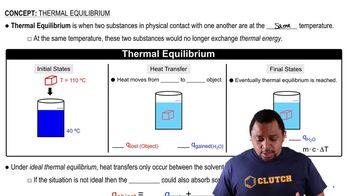Here are the essential concepts you must grasp in order to answer the question correctly.
Equilibrium Constant (Kc)
The equilibrium constant, Kc, is a numerical value that expresses the ratio of the concentrations of products to reactants at equilibrium for a given reaction at a specific temperature. For the reaction 2A ⇌ B, Kc is calculated as [B]/[A]^2. A Kc value of 1 indicates that at equilibrium, the concentrations of products and reactants are equal when raised to their respective stoichiometric coefficients.
Recommended video:
Equilibrium Constant Expressions
Chemical Equilibrium
Chemical equilibrium occurs when the rates of the forward and reverse reactions are equal, resulting in constant concentrations of reactants and products over time. In the context of the reaction 2A ⇌ B, this means that the concentrations of A and B will stabilize at certain values, reflecting the balance between the formation of B from A and the conversion of B back to A.
Recommended video:
Chemical Equilibrium Concepts
Concentration Relationships at Equilibrium
At equilibrium, the concentrations of reactants and products are related through the equilibrium constant. For Kc = 1 in the reaction 2A ⇌ B, it implies that the concentration of B is equal to the square of the concentration of A, or [B] = [A]^2. This relationship helps predict how changes in concentration will affect the system and the position of equilibrium.
Recommended video:
 Verified step by step guidance
Verified step by step guidance

